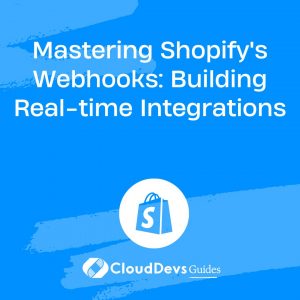How to use Shopify’s API for scalability
In today’s rapidly evolving digital marketplace, scalability and customization are the keys to business success. Shopify, a leading eCommerce platform, provides its users with an adaptable environment that encourages growth. Shopify’s robust API forms a crucial part of this scalability by allowing developers to build custom apps, thereby extending the platform’s core functionality.
Understanding the complexities of the API and leveraging it to its full potential might seem daunting. In this case, one smart move could be to hire Shopify developers. They can help you tap into the power of Shopify’s API, creating custom applications that perfectly align with your business needs.
This blog post will delve into Shopify’s API, providing examples of how it can be used to create custom applications, and shed light on the advantages you gain when you hire Shopify developers to extend your online store’s functionality.
An Introduction to Shopify API
Shopify’s API (Application Programming Interface) is a powerful tool that allows developers to interact with Shopify data directly. Through the API, you can manipulate resources like products, collections, orders, shipping, and more, extending the native capabilities of Shopify.
The API is organized around REST, ensuring that our interactions with Shopify are intuitive and straightforward. It adheres to standard HTTP protocols, where the API’s resources are accessed via standard HTTP methods (GET, POST, PUT, DELETE).
Building a Custom App
Setting Up
Let’s walk through the creation of a basic custom app that manipulates product data. First, you will need to create a new app in your Shopify Partner Dashboard. Once done, you will receive credentials, including an API key and API secret key, which will be used to authenticate your app with Shopify.
Making Your First API Call
Before diving into coding, let’s get familiar with how the API works. Shopify provides an interactive API explorer, which allows you to test API calls directly within your browser.
Try fetching a list of your store’s products using a GET request to the /admin/api/2023-07/products.json endpoint. The JSON response will include detailed information about your products.
Building the App
Let’s create a simple Node.js application that fetches and displays a list of products in your store.
Install the necessary dependencies:
```bash npm install express shopify-api-node dotenv ```
Create an .env file to securely store your credentials:
```bash SHOPIFY_API_KEY=your-api-key SHOPIFY_API_SECRET=your-api-secret SHOPIFY_STORE_URL=your-store-url.myshopify.com ```
In your main app file, set up Shopify API and make a request to fetch products:
```javascript
const express = require('express');
const Shopify = require('shopify-api-node');
require('dotenv').config();
const app = express();
const shopify = new Shopify({
shopName: process.env.SHOPIFY_STORE_URL,
apiKey: process.env.SHOPIFY_API_KEY,
password: process.env.SHOPIFY_API_SECRET,
});
app.get('/products', async (req, res) => {
const products = await shopify.product.list();
res.json(products);
});
const PORT = process.env.PORT || 5000;
app.listen(PORT, () => console.log(`Server running on port ${PORT}`));
```
This app will fetch and display a list of products when you navigate to the /products route.
Expanding Your App’s Capabilities
The above example is a basic demonstration of what Shopify’s API can do. However, the possibilities are virtually endless. Below are a couple of ideas for expanding your app’s capabilities:
Automating Order Fulfillment
Using Shopify’s Order API, you can build an app that automates the order fulfillment process. For instance, once an order is created, the app can automatically send a request to your warehouse management system, hastening the order fulfillment process.
Creating Custom Reports
Shopify does provide some reporting capabilities, but they might not always meet your specific needs. You could create a custom app that uses the Analytics API to fetch sales data and generate detailed, custom reports.
Best Practices
When developing custom apps with Shopify’s API, consider the following best practices:
– Rate Limiting: Shopify uses a leaky bucket algorithm for rate limiting. This means that your app can make a certain number of requests in a given time frame. Exceeding this limit will result in HTTP 429 Too Many Requests responses. Always handle these scenarios gracefully in your app.
– Webhooks: Instead of continually polling Shopify for changes (like a new order), use webhooks. Webhooks are a way for Shopify to notify your app when a specified event occurs.
– Security: Always store your API keys and other sensitive information securely. Never expose these details in your client-side code. Also, ensure all data transfers occur over HTTPS.
– Pagination: Shopify uses cursor-based pagination. Instead of using page numbers to navigate through lists, your app should follow the links for next and previous in the response headers.
– Error Handling: Always implement proper error handling in your app. Shopify’s API can return a variety of HTTP status codes and error messages, which your app should handle appropriately.
Conclusion
Shopify’s API provides an extensive array of possibilities for customizing and extending your eCommerce store. Whether you’re looking to automate tasks, integrate with other systems, or add new features, the API offers the flexibility and scalability your business needs to grow and thrive in the digital marketplace.
However, harnessing this power may require technical expertise. Hiring Shopify developers can be an excellent decision in this regard. These experts can develop custom apps that tailor Shopify’s functionality to your specific business needs, providing a more streamlined, efficient, and effective eCommerce experience for both you and your customers.
So, don’t wait—start exploring the potential of Shopify’s API with skilled developers today, and drive your business towards unprecedented growth.
Table of Contents









